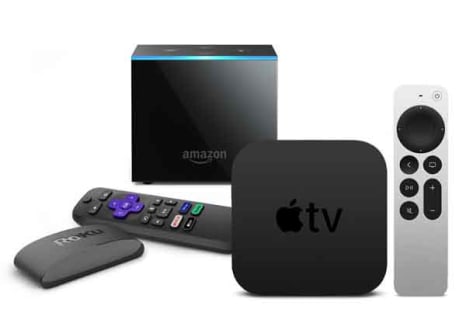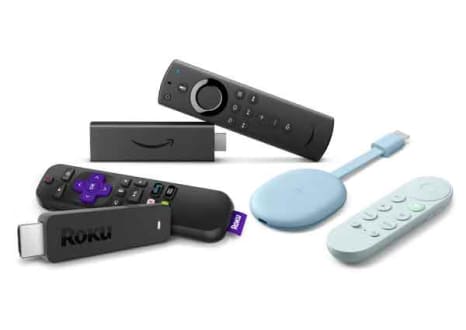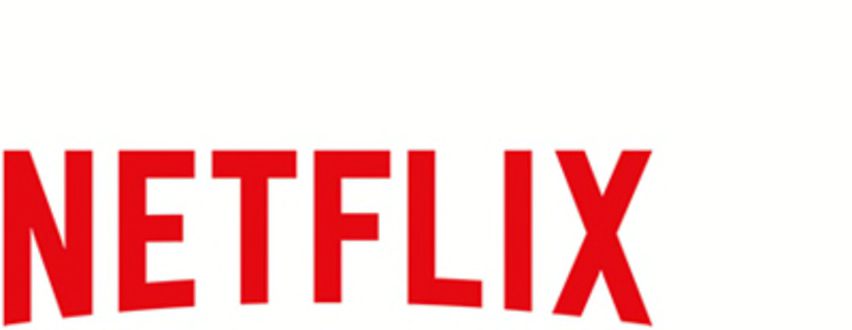
Streaming Media Device Buying Guide

Senior Home & Tech Editor
With the ever-growing number of streaming options available—both paid and free—it’s no surprise that every year more of us cut the cord with our cable or satellite company. In fact, traditional pay-TV providers lost 4 million subscribers in the first half of 2024 alone, according to equity research company MoffettNathanson.
Whether or not you’ve cut the cord, you probably subscribe to at least one streaming service. More than half of American households say they subscribe to four or more streaming services, according to a nationally representative survey [PDF] of 2,097 U.S. adults conducted by CR in February 2023. And almost 1 in 10 subscribe to nine or more. (Scroll to the bottom for more information on streaming options.)
Most televisions these days are smart TVs with the ability to access a variety of streaming services from the internet. Blu-ray players and the major video game consoles may have this feature, too.
Otherwise, a dedicated streaming media device is a simple, relatively inexpensive way to make any TV a smart one. And even if your TV is already internet-capable, a dedicated streaming device may be more convenient to use or more powerful, or it may offer some services you can’t get from your specific television. I’ve added external streaming devices to several smart TVs in my home.
At Consumer Reports, we test streaming media devices thoroughly, and we’ve found that, generally, they’re reasonably priced and simple to connect. Plug them into your TV, then connect to your wireless network and you’re good to go.
Types of Devices
The market for streaming media devices is dominated by just a few major platforms. These include Amazon (Fire TV), Apple (Apple TV), Google (Android/Google TV), and Roku. The newest models now support 4K videos with high dynamic range (HDR). You can choose between set-top boxes and stick-style devices that plug directly into a TV’s HDMI input—these small devices often have fewer connections and features, but they’re also unobtrusive.

Set-Top Boxes
You can get a set-top-box streaming device from companies including Apple (Apple TV 4K), Amazon (Amazon Fire TV Cube, Amazon Fire TV Stick 4K, Amazon Fire TV Stick 4K Max), Google (Google TV Streamer 4K), Nvidia (Nvidia Shield TV), Onn (Onn 4K Pro Streaming Device), and Roku (Roku Ultra, Roku Streaming Stick 4K, Roku Express 4K+).
Set-top boxes may have more connections than stick-style players. For instance, they can include USB ports for playing personal media or an Ethernet jack for a wired connection to your home network. These boxes connect to your TV via an HDMI cable.

Plug-In Devices
A variety of plug-in streaming media device models are available from Amazon, Google, Roku, and TiVo, among other companies. Many brands offer both HD and 4K models that support HDR, though some companies have begun offering 4K models only. Given the small price differences between HD and 4K models, the latter make the most sense for new buyers.
Some of these devices are about the size and shape of a USB flash drive, while others, such Google’s older Chromecast players—which are being phased out—have a unique shape. All plug into your TV’s HDMI port and draw power from either the TV’s USB port or an AC wall outlet.
Is Your Broadband Fast Enough?
Your internet connection will help determine picture quality: Netflix and other services adjust the signal you get based on the speed of your internet connection. So if Gal Gadot’s jawline seems less than chiseled or that rom-com won’t play without buffering, buffering, buffering . . . you may need a more robust broadband connection or some adjustments to your WiFi network.
You’re Likely to Need a Speed of at Least 50 Mbps
Five megabits per second is the absolute minimum to support a high-definition stream, but that’s barely adequate, and only if you’re streaming to just one device at a time. Most homes these days will need at least 25 megabits per second, the Federal Communications Commission’s definition of high-speed broadband—and that’s if you’re streaming 4K videos and nothing else. (Most services recommend 15 to 25 Mbps speeds for 4K videos.) And with so many people working remotely and streaming more entertainment than ever, you may need much faster speeds. (Check out "How Much Internet Speed Do You Need?" for a calculator that can help you figure it out.) The good news is that the average broadband download speed in the U.S. is now over 200 Mbps, according to SpeedTest.net, though median upload speeds are considerably slower.
Regardless of how fast your connection is, picture quality may initially be poor but then improve after a minute or so as the service adjusts to the connection speed.
4K Video With HDR Is Now Common
All streaming services can deliver ordinary high-definition picture quality. But most also now offer lots of 4K content as well. That includes Amazon Prime Video, Apple TV+, Disney+, Fubo TV, HBO Max, Paramount+, Peacock, and Netflix, among others. Most of these services also now support 4K videos with high dynamic range (HDR). But as noted above, you’ll need a relatively fast connection, at least 15 to 25 Mbps, just to stream 4K content.
Features That Matter
4K HDR Capability
All the major streaming player brands now offer models that support 4K videos with HDR. It’s probably worth getting one of these models because almost all new televisions are 4K models, and streaming services provide lots of 4K content.
The Right Connections
All streaming media devices have built-in WiFi, and some have an Ethernet jack for a wired connection to a modem or router. All can hook up to TVs via HDMI connections, but it’s getting harder to find models with legacy analog-video connections for use with older TVs that lack an HDMI input. Some players include a USB port for playing your own media, such as music and photos, through the device.
Organized Apps
As more channels become available on these devices, the ability to reorder (or delete) apps and customize your home screen is a plus. It helps you avoid having to scroll through seldom-used options.
Universal Search
You’ll appreciate models that can search across multiple services to find shows and movies so that you don’t have to check each service individually.
Faster WiFi
A streaming device with dual-band WiFi can help performance by relegating video streaming to the higher 5-gigahertz frequency band, sidestepping possible interference with other devices at home, such as cordless phones and microwaves, that operate on the 2.4-GHz frequency. Models that support the 802.11ac standard, referred to as WiFi 5, are very common, but many newer players now support the WiFi 6 and WiFi6e standards, which offer faster speeds and the ability to support more devices. Your wireless router also needs to support WiFi 6 to get those benefits, but a WiFi 6 streaming device will work fine with older routers. There’s an even newer WiFi 7 standard, but so far we haven’t seen any streaming players that support it.
Well-Designed Remotes
All but the most basic models come with remotes that have embedded microphones, so you can search using voice terms, which is easier than typing using an onscreen keyboard. There are also some rechargeable remotes, so you don’t have to go searching for replacement batteries. Dedicated buttons for the most used services allow for easy access, and programmable buttons allow you to set up shortcuts to quickly open apps or access settings. Backlit buttons come in handy on family movie night when the lights are low. Most of the devices offer apps that let you use your smartphone as a remote control.
Picking Your Streaming Services
Online streaming services offer unprecedented viewing options for either those looking to supplement what they get from cable or those who want to eliminate it entirely. (We can show you how to cut cable TV for about $25 per month.)
There are now several ways to go. All-you-can-eat subscription services—such as Amazon, Hulu, and Netflix—are now joined by Apple TV+, Disney+, Max (formerly HBO Max), Paramount+, and Peacock. They offer unlimited streaming for a fee, typically around $7 to $20 per month. Cable-style live TV services (DirecTV Stream, Fubo, Hulu + Live TV, Sling TV, YouTube TV) offer both local and cable channels for anywhere from about $45 to $85 per month. And free streaming services (Freevee, Pluto TV, the Roku Channel, Tubi TV) require you to watch advertisements instead of paying.
Finally, you can use pay-per-view services, where you rent or buy individual movies or shows on an à la carte basis.
Almost everyone seems to have one or several subscription services, but they’re not right for everyone, especially as their prices march upward. Services like Netflix make the most sense for those who watch a lot of shows and movies, like to binge-watch several shows or even entire seasons of a series, or are fans of exclusive shows and movies (“Lord of the Rings: The Rings of Power” on Amazon, “Stranger Things” on Netflix) that aren’t available elsewhere.
That has caused more of us to change our streaming habits. According to research firm Parks Associates, 36 percent of streaming customers are already “service hoppers,” who subscribe to a streaming service for a month or so, binge-watch all the shows they like, and then cancel, moving to different services multiple times over a period of 12 months.
If you watch only one or two movies or shows a month and prefer more current releases, a pay-per-view service is the better bet.
Here’s a breakdown of the “big three” subscription services.

Amazon Prime Video
Cost: $15 per month or $139 per year, $9 per month for a video-only subscription.
Content: Original series include the popular “The Marvelous Mrs. Maisel”; “The Wheel of Time,” an epic fantasy adventure; and “Reacher,” based on the best-selling Lee Child novels. You also get movies and sports, such as the NFL’s Thursday Night Football, NBA and WNBA matchups, and some New York Yankees games.
Pros: Free with an Amazon Prime subscription for two-day delivery, a growing content library, free Amazon Prime Music, and access to Prime Day shopping events.
Cons: Rising price, lost access to HBO shows with the launch of WarnerMedia’s Max service.
Devices: Wide device support, including smart TVs, streaming media players, and mobile devices.

Hulu
Cost: $10 per month with ads (or $100 annually), $19 per month without.
Content: Current and past seasons of broadcast TV shows, movies, and some originals, such as “The Handmaid’s Tale” and “Little Fires Everywhere.”
Pros: Current and previous ABC, Fox, and some CBS and NBC shows. There are a growing number of original series, including “Only Murders in the Building” and "The Bear." Bundle plans, with Disney+ or Disney+ and ESPN+, are available from $11 to $27 a month, depending on whether it includes ads.
Cons: Lower prices include ads, and many newer CBS and NBC shows have moved to Paramount+ and Peacock, respectively. Also, the price for Hulu, like other streaming services, keeps rising.
Devices: Almost universal device support.

Netflix
Cost: $7 for an ad-supported Standard With Ads tier in HD, $10 a month for a no-ad Basic HD plan, $15.50 per month for a Standard plan in full HD, and $23 a month for the Premium plan with 4K HDR videos and more simultaneous users.
Content: Movies ("All Quiet on the Western Front," "Beverly Hills Cop: Axel F"), original series ("Wednesday," “Bridgerton,” "Squid Game," and “Stranger Things"), and lots of licensed content.
Pros: Vast selection of content, compelling original TV shows and movies, wide device support.
Cons: Prices continue to climb, and Netflix lost access to most Disney, Pixar, Marvel, and Star Wars content with the launch of Disney+. Also, Netflix’s cheapest ad-free plan, which costs $10 a month, is no longer available to new subscribers. Those who currently have it can keep it, but the least expensive ad-free plan for those just signing up is $15.50.
Devices: Almost universal device support.
Streaming Media Brands
A handful of big-name brands dominate the market.
Amazon sells a variety of streaming media players under its Fire TV brand, including both HD and 4K HDR models. They range from inexpensive stick-style players, which plug directly into a TV’s HDMI port, to the Fire TV Cube, a pricier model that lets you control other devices. All have Amazon’s voice-powered Alexa digital assistant. There are also a number of TVs, from brands including Amazon, Insignia, Panasonic, and Toshiba, that use the Fire TV smart system.
Apple is no longer selling its HD (1080p) Apple TV, migrating to the newer Apple TV 4K players that come with a much-improved remote control. The devices come with either 64 gigabytes or 128GB of storage and let you buy or rent movies and TV shows from iTunes. They also provide access to Apple TV+, as well as a variety of other services, such as Netflix, Amazon Prime Video, Hulu, and Disney+. Apple TV can use AirPlay to share content stored on portable iOS devices or a Mac computer on the TV.
Google had offered two odd-shaped Chromecast with Google TV streaming media devices—a lower-priced 1080p model and a newer 4K HDR Chromecast with Google TV player—but they are being phased out. (They are still available at some retailers.) Those models are being replaced by the Google TV Streamer (4K), a pricier ($100) wedge-shaped set-top box model that is noticeably faster than either Chromecast model. It supports both Dolby Vision and HDR10+ HDR formats, as well as Dolby Atmos audio, and has Google Assistant built in. There are other Google TV-based models on the market, including the Onn Google TV Streaming Box, from Walmart’s house brand, as well as some older players that use Google’s Android system.
Perhaps best known for performance-based computer graphics cards targeted toward gamers, Nvidia now offers two set-top boxes, the Shield TV and Shield TV Pro, which use the older Android TV smart system. Both models offer strong video gameplay. The Shield TV model has a cylindrical design, and the Pro has a unique, angular look. The Pro also has more memory and storage. Both are 4K models that support Dolby Vision HDR, plus Dolby Atmos immersive audio.
Roku shipped its first streaming device in 2008, helping to create the category. It offers a few set-top boxes, plus a stick-style player and two soundbars that have Roku players built in. The Roku TV platform has been built into TV sets from several companies, including Hisense and TCL, though there are now fewer Roku TV models from other brands. Perhaps as a result, Roku now makes and sells its own sets. It has a wide range of content, including access to Amazon, Hulu, and Netflix, plus hundreds of niche channels.



























